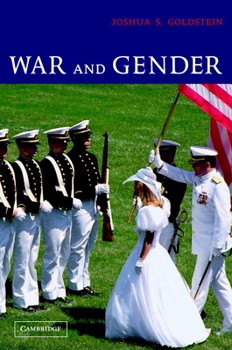War and Gender: How Gender Shapes the War System and Vice Versa
Select Format
Select Condition 
Book Overview
Gender roles are nowhere more prominent than in war. Yet contentious debates, and the scattering of scholarship across academic disciplines, have obscured understanding of how gender affects war and vice versa. In this authoritative and lively review of our state of knowledge, Joshua Goldstein assesses the possible explanations for the near-total exclusion of women from combat forces, through history and across cultures. Topics covered include the history of women who did fight and fought well, the complex role of testosterone in men's social behaviours, and the construction of masculinity and femininity in the shadow of war. Goldstein concludes that killing in war does not come naturally for either gender, and that gender norms often shape men, women, and children to the needs of the war system. lllustrated with photographs, drawings, and graphics, and drawing from scholarship spanning six academic disciplines, this book provides a unique study of a fascinating issue.
Format:Paperback
Language:English
ISBN:0521001803
ISBN13:9780521001809
Release Date:August 2003
Publisher:Cambridge University Press
Length:523 Pages
Weight:1.87 lbs.
Dimensions:1.3" x 6.0" x 9.1"
Customer Reviews
3 ratings
It be blowing my mind
Published by Thriftbooks.com User , 16 years ago
I was not expecting much from War and Gender. But this book radically changed how I looked at the constructions of gender. It's phenomenal.
Excellent Overview of Gender Issues
Published by Thriftbooks.com User , 17 years ago
This book, though primarily focused on the issue of the warmaking propensities of the genders, is actually a sound overall assessment of gender culture, history and sociology. The author's (Mr. Goldstein) feminist bias is evident but he makes unfiltered evaluations of the sometimes ambiguous facts. His recitation of the statistics involved in this research does get a bit tedious at times, and I'll admit I found the history and cultural studies more interesting than the dry numerical comparisons and graphs (as an engineer, I get enough of that at work.). He cites the few instances of women in combat, especially the Dahomey all-female regiments in the 19th century and the stubborn woman warriors in our own Civil War, several of whom were wounded, had their sex exposed, were drummed out of their unit, and promptly found another unknowing miltary faction who bought the deception all over again. Hollywood, where are you? His insistence on using our DNAS-kin primates as comparators of social-warfare behavior I found to be of limited use, as, ultimately, I believe he did. This stuff could have been significantly curtailed. But his description of human heterosexuality, homosexuality, prostitution, labor substitution, women in the military and temporary women's liberation during war time was most enlightening. He makes a good case that women actualy serve to enable and enforce men's war making proclivities by spurning them as womanly cowards if they retreat on the battlefield and also serve as key elements in the patriotic zeitgeist mobilized by government propaganda. Interestingly, the role of testosterone in war making tendencies seems to be muted at best, despite its universally recognized potential for aggressive behavior. Goldstein also demonstrates that women have been as big an advocate of war as they have been war protestors, so that the mythology of women as natural peacelovers is little more than that. The book also discusses the dichotomy society finds itself in when it talks of desiring peace; it promotes the romance of war almost from the conception of the male child and praises all the warrior virtues as virtually the only acceptable definition of manliness. Goldstein, at the end, mildly endorses sports as an alternative for these military energies, but without much conviction. I, for one, think that war and killing is as essential to the human makeup as the need to love and procreate is, the yin and yang of humanity. The idea of universal peace is as contrary to the natural order of things as black would be without white. That is not a PC view of life but that's what any reader of history must inevitably surmise.
The Feminist Male Maker
Published by Thriftbooks.com User , 20 years ago
Goldstein's approach should grab male readers especially interested in understanding how gender shapes the war system, for he comes at it from an interdisciplinary angle that attempts to thoroughly cover the popular explanations for gender roles in war and then challenge them with the most up to date evidence. His conclusion after all of this is that gender roles are not inevitable or inherent in human nature, but that human culture, responding to subtle differences between the genders, shapes the war system along gendered lines. A must read for all gender scholars and activists.





